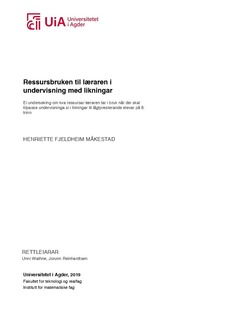| dc.contributor.author | Måkestad, Henriette Fjeldheim | |
| dc.date.accessioned | 2019-10-22T07:48:08Z | |
| dc.date.available | 2019-10-22T07:48:08Z | |
| dc.date.issued | 2019 | |
| dc.identifier.uri | http://hdl.handle.net/11250/2623619 | |
| dc.description | Masteroppgave matematikkdidaktikk MA502 – Universitetet i Agder 2019 | nb_NO |
| dc.description.abstract | The purpose of this study is to gain insightinto teachers use of resources in teachingwhen working withequationsandlow-achievingpupils. The research questionis:Whichresources does the teacher use in teaching with equations towards thelow-achievementpupils in 8thgrade?The theoretical framework used in this study explains the concepts of resources, algebra in school and adapted education. Several definitions and concepts of resources are discussed and defined.These includematerial resources, cultural resources and knowledge resources.A part of the theoretical framework are the four knowledge resources illuminated by Adler (2012). The analyse of the data material are based on these four knowledge resources which are adapted to this study. Furthermore, research exploring pupils understanding of algebra, equations and the equals sign is presented. Different views and perspectivesof adapted education in school areexplained. To answer theresearch question, semi-structuredinterviews were conducted with three teachers. They were asked about their experience and practiceregardingtheiruse of resources in teaching when working with equations and low-achievingpupils. They were askedto talk aboutresources they used,included why and how these were used. Their statement were then analyzed regarding the knowledge resources the teachers drew from when they explained and justified the use of material and cultural resources. The results of this study show that the three teachers usesome of the same material and cultural resources. All of them drew from the four knowledge resourceswhen explaining their teaching practices, but to different extent. The teachers doesn ́t use the printed textbook in the same amount as before. The teachers useanother form of the textbook. One of the teachers uses booklets of tasks and one teacher use a digital textbook. Two of the teachers uses digital lectures. Regarding the use of manipulatives two of the teachers uses a lot of matchboxes in their teaching with equations. Cultural resources described are pupilsas resources for each other and the teacher as a resource for the pupils. One of the teachers focuses on the mathematiclanguage in the teaching as a resource.Regarding the use of the four knowledge resources, a prominent finding isthat all the teachersrely on their professional knowledge to adapt their teaching when working with equations and low-achieving pupils. One of the teachers drew more from the everyday knowledge than the two other teachers while one of the teachers drew more from their curriculum knowledge. A prominent finding in use of the mathematical knowledge show two teachers drew the same amount from this knowledge resource compared to the other knowledge resources. A point of interest is that one of them emphasize the teaching in a way to aim the pupils to learn a relational understandingof the subjectwhile the other teacher expresses more efficient towards learning the pupils the instrumental understanding of the subject. | nb_NO |
| dc.language.iso | nob | nb_NO |
| dc.publisher | Universitetet i Agder ; University of Agder | nb_NO |
| dc.rights | Attribution-NonCommercial-NoDerivatives 4.0 Internasjonal | * |
| dc.rights.uri | http://creativecommons.org/licenses/by-nc-nd/4.0/deed.no | * |
| dc.subject | MA502 | nb_NO |
| dc.title | Ressursbruken til læraren i undervisning med likningar : Ei undersøking om kva ressursar læraren tar i bruk når dei skal tilpasse undervisninga si i likningar til lågtpresterande elevar på 8. trinn | nb_NO |
| dc.type | Master thesis | nb_NO |
| dc.subject.nsi | VDP::Samfunnsvitenskap: 200::Pedagogiske fag: 280::Fagdidaktikk: 283 | nb_NO |
| dc.source.pagenumber | 122 s. | nb_NO |

